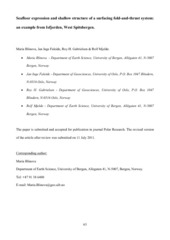| dc.contributor.author | Blinova, Maria | eng |
| dc.contributor.author | Faleide, Jan Inge | eng |
| dc.contributor.author | Gabrielsen, Roy H. | eng |
| dc.contributor.author | Mjelde, Rolf | eng |
| dc.date.accessioned | 2012-06-26T12:13:07Z | |
| dc.date.available | 2012-06-26T12:13:07Z | |
| dc.date.issued | 2012 | eng |
| dc.Published | Polar Research 31(11209) | |
| dc.identifier.issn | 1751-8369 | en_US |
| dc.identifier.uri | https://hdl.handle.net/1956/5862 | |
| dc.description | Published with the title: Seafloor expression and shallow structure of a fold-and-thrust system, Isfjorden, west Spitsbergen | |
| dc.description.abstract | A detailed map of the structure of the West Spitsbergen Fold-and-Thrust Belt in the shallow part of the Isfjorden area, Spitsbergen, is presented. The map was constructed from a new dense grid of 2D multichannel reflection seismic and bathymetrical surveys. Interpretation of two different datasets gave a possibility to observe and compare tectonic structures detected along the uppermost part of the seismic sections and those reflected in morphological data at the seafloor. Correlation of the tectonic structures as expressed in the two datasets shows a good match and three major thrust faults were identified. The outcropping thrusts display a dominant NW-SE strike. The westernmost thrust fault (T1) is an out-of-sequence hinterland-directed thrust, whilst the central and easternmost thrust faults (T2 and T3) represent foreland-directed in-sequence thrusting. The thrusts divide Isfjorden into three subareas. Subarea 1 is bounded by thrust faults T1 and T2 and comprises Tertiary rocks surrounded by Jurassic-Cretaceous strata. The structural signature of Subarea 1 is that of a system of hinterland- and foreland-directed thrust faults, resulting in a seafloor relief characterized by parallel ridges and lows. Subarea 2 is limited by thrust faults T2 and T3. It includes an area of Jurassic-Cretaceous strata outcropping on the seafloor. Subarea 3 is situated east of the main thrust fault T3, and mainly incorporates outcrops of Triassic-Jurassic rocks. Together, Subareas 2 and 3 are dominated by foreland-directed thrusting with NW-SE and NNW-SSE strike directions, which are hardly detectable in bathymetric data. | en_US |
| dc.language.iso | eng | eng |
| dc.publisher | Norwegian Polar Institute | en_US |
| dc.relation.ispartof | <a href="http://hdl.handle.net/1956/5863" target="blank">Seismic study along the west Spitsbergen continental margin and adjacent area of the West Spitsbergen Fold and Thrust Belt (Isfjorden)</a> | en_US |
| dc.rights | Attribution-NonCommercial CC BY-NC | eng |
| dc.rights.uri | http://creativecommons.org/licenses/by-nc/3.0/ | eng |
| dc.title | Seafloor expression and shallow structure of a surfacing fold-and-thrust system: an example from Isfjorden, West Spitsbergen | en_US |
| dc.type | Peer reviewed | |
| dc.type | Journal article | |
| dc.description.version | acceptedVersion | en_US |
| dc.rights.holder | Copyright 2012 M. Blinova et al. | en_US |
| dc.identifier.doi | https://doi.org/10.3402/polar.v31i0.11209 | |
| dc.identifier.cristin | 965162 | |
| dc.source.journal | Polar Research | |
| dc.source.40 | 31 | |
| dc.source.14 | 11209 | |
| dc.subject.nsi | VDP::Mathematics and natural science: 400::Geosciences: 450::Marine geology: 466 | en_US |

